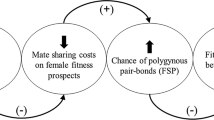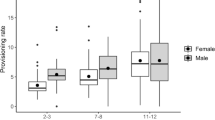Abstract
Many socially monogamous bird species follow a genetically promiscuous reproductive strategy. Duetting birds may be an exception, as they appear to exhibit very low levels of extra pair paternity—which is thought to be connected to duetting. Duets are predicted to function either in paternity guarding or as signals of commitment to the pair bond, reciprocally reducing extra pair mating in both sexes. In this study, we used four microsatellites to document paternity loss in the Crimson-breasted Shrike (Laniarius atrococcineus), a socially monogamous subtropical duetting species. Extra pair paternity was surprisingly high, with extra pair males siring 20 % of young in 30 % of broods. Furthermore, we compared the levels of extra pair paternity of each pair to certain characteristics of their duets to test the paternity guard and the commitment hypotheses. Our results offered no support that duets function in paternity guarding, although the fact that males which had been cuckolded answered more of their female’s calls could represent an adaptation to avoid future cuckoldry. We also found no evidence for duets functioning as signal of commitment. Female vocal behaviour was in fact the reverse of that predicted: Levels of infidelity amongst social females were positively related to female answer rate of their mates’ songs. These results indicate that females may use increased answer rates as a form of manipulation, in an attempt to avoid potential costs associated with their extra pair matings.
Similar content being viewed by others
References
Benedict L (2008) Unusually high levels of extra pair paternity in a duetting songbird with long-tem pair bonds. Behav Ecol Sociobiol 62:983–988
Benedict L (2010) California towhee vocal duets are multi-functional signals for multiple receivers. Behaviour 147:953–978
Catchpole CK, Slater PJB (2008) Bird song: biological themes and variations. Cambridge University Press, Cambridge
Clutton-Brock TH, Gaynor D, McIlrath GM, MacColl ADC, Kansky R, Chadwick P, Manser M, Skinner JD, Brotherton PNM (1999) Predation, group size and mortality in a cooperative mongoose, Suricata suricatta. J Anim Ecol 68:672–683
Cramer ERA, Hall ML, De Kort SR, Lovette IJ, Vehrencamp SL (2011) Infrequent extra-pair paternity in the banded wren, a synchronously breeding tropical passerine. Condor 113:637–645
Dilger WC (1953) Duetting in the Crimson-breasted Barbet. Condor 55:220–221
Douglas SB, Heath DD, Mennill DJ (2012) Low levels of extra-pair paternity in a neotropical duetting songbird, the Rufus-and-white Wren (Thryothorus rufalbus). Condor 114:393–400
Farabaugh SM (1982) The ecological and social significance of duetting. In: Kroodsma DE, Miller DH (eds) Acoustic communication in birds, vol 2. Academic Press, New York, pp 85–124
Field A (2009) Discovering statistics using SPSS, 3rd edn. Sage Publications, London
Fleischer RC, Tarr CL, Morton ES, Sangmeister A, Derrickson KC (1997) Mating system of the dusky antbird, a tropical passerine, as assessed by DNA fingerprinting. Condor 99:512–514
Friedl TWP, Klump GM (1999) Determinants of male mating success in the red bishop (Euplectes orix). Behav Ecol Sociobiol 46:387–399
Gill SA, Vonhof MJ, Stutchbury BJM, Morton ES, Quinn JS (2005) No evidence for acoustic mate-guarding in duetting Buff-breasted Wrens (Thryothorus leucotis). Behav Ecol Sociobiol 57:557–565
Grafe TU, Bitz JH (2004) Functions of duetting in the tropical boubou, Laniarius aethiopicus: territorial defence and mutual mate guarding. Anim Behav 68:193–201
Grafe TU, Bitz JH, Wink M (2004) Song repertoire and duetting behaviour of the tropical boubou, Laniarius aethiopicus. Anim Behav 68:181–191
Griffith SC, Owens IPF, Thuman KA (2002) Extra-pair paternity in birds: a review of interspecific variation and adaptive function. Mol Ecol 11:2195–2212
Griffiths R, Double MC, Orr K, Dawson RJB (1998) A DNA test to sex most birds. Mol Ecol 7:1071–1075
Haggerty TM, Morton ES, Fleischer RC (2001) Genetic monogamy in Carolina Wrens (Thryothorus ludovicianus). Auk 118:215–219
Hall ML (2004) A review of hypotheses for the functions of avian duetting. Behav Ecol Sociobiol 55:415–430
Hall ML (2009) A review of vocal duetting in birds. Adv Stud Behav 40:67–94
Hall ML, Magrath RD (2000). Duetting and mate-guarding in Australian magpie-larks (Grallina cyanoleuca)
Hall ML, Peters A (2009) Do male paternity guards ensure female fidelity in a duetting fairy-wren? Behav Ecol 20:222–228
Hockey PAR, Dean WRJ, Ryan PG (2005) Robert’s birds of southern Africa, 7th edn. The Trustees of the John Voelcker Bird Fund, Cape Town
Kalinowski ST, Taper ML, Marshall TC (2007) Revising how the computer program CERVUS accommodates genotyping error increases success in paternity assignment. Mol Ecol 16:1099–1006
Krebs JR, Dawkins R (1984) Animal signals: mind-reading and manipulation. In: Krebs JR, Davies NB (eds) Behavioural ecology: an evolutionary approach. Sinauer. Sunderland, Massachusetts, pp 380–402
Langmore NE (1998) Functions of duet and solo songs of female birds. Trends Ecol Evol 13:136–140
Lawless SG, Ritchison G, Klatt PH, Westneat DF (1997) The mating strategies of Eastern Screech-Owls: a genetic analysis. Condor 99:213–217
Levin RN (1996a) Song behaviour and reproductive strategies in a duetting wren, Thryothorus nigricapillus. I. Removal experiments. Anim Behav 52:1093–1106
Levin RN (1996b) Song behaviour and reproductive strategies in a duetting wren, Thryothorus nigricapillus. II. Playback experiments. Anim Behav 52:1107–1117
Logue DM (2007) Duetting in space: a radio-telemetry study of the black-bellied wren. Proc R Soc Lond B 274:3005–3010
Marshall- Ball L, Mann N, Slater PJB (2006) Multiple functions to duet singing: hidden conflicts and apparent cooperation. Anim Behav 71:823–831
Mennill DJ, Vehrencamp SL (2008) Context-dependent functions of avian duets revealed by microphone-array recordings and multispeaker playback. Curr Biol 18:1314–1319
Merkle TFC (2006) Territoriality, breeding biology and vocalisations of the Crimson-breasted Shrike. Ostrich 77:136–141
Price JJ (2009) Evolution and life history correlates of female song in the New World blackbirds. Behav Ecol 20:967–977
Ridley AR, van den Heuvel IM (2012) Is there a difference in reproductive performance between cooperative and non-cooperative species? A southern African comparison. Behaviour 149:821–848
Rogers AC, Langmore NE, Mulder RA (2007) Function of pair duets in the eastern whipbird: cooperative defense or sexual conflict? Behav Ecol 18:182–188
Seibt U, Wickler W (1977) Duettieren als Revier-Anzeige bei Vögeln. Z Tierpsychol 43:180–187
Slater PJB, Mann NI (2004) Why do the females of many bird species sing in the tropics? J Avian Biol 35:289–294
Smith WJ (1994) Animal duets: forcing a mate to be attentive. J Theor Biol 166:221–223
Sonnenschein E, Reyer H-U (1983) Mate-guarding and other functions of antiphonal duets in the slate-coloured boubou (Laniarius funebris). Z Tierpsychol 63:112–140
Stokes AW, Williams HW (1968) Antiphonal calling in quail. Auk 85:83–89
Tarboton WR (1971) Breeding biology of the Crimson-breasted Shrike at Olifantsfontein, Transvaal. Ostrich 42:271–290
Tarboton WR (1998) The Crimson-breasted Shrike: scarlet skulker. Africa Birds Birding 3:30–35
Thorpe WH, North MEW (1966) Vocal imitation in the tropical bou-bou shrike Laniarius aethopicus major as a means of establishing and maintaining social bonds. Ibis 108:432–435
Tobias JA, Seddon N (2009) Signal jamming mediates sexual conflict in a duetting bird. Curr Biol 19:577–582
Valera F, Hoi H, Kristín A (2003) Male shrikes punish unfaithful females. Behav Ecol 14:403–408
van den Heuvel IM, Cherry MI, Klump GM (2013) Individual identity, song repertoire and duet function in the Crimson-breasted Shrike (Laniarius atrococcineus). Bioacoustics 22:1–15
Wachtmeister CA (2001) Display in monogamous pairs: a review of empirical data and evolutionary explanations. Anim Behav 61:861–868
Westneat DF, Sherman PW (1993) Parentage and the evolution of parental behavior. Behav Ecol 4:66–77
Wickler W (1980) Vocal duetting and the pair bond. I. Coyness and partner commitment. A hypothesis. Z Tierpsychol 52:201–209
Acknowledgments
We thank Prof. Tim Clutton-Brock, Prof. Marta Manser and the Kuruman Reserve Trust for access to the study site. Michiel Jooste, Thomas Klinner and Benjamin Gnep assisted with field observations. Thomas W.P. Friedl and Elisabeth Groscurth kindly helped with laboratory techniques. We are very grateful to Tristan Marshall for his advice and guidance through the CERVUS programme and for allowing us to use the trial version 3.0.5. Two anonymous reviewers significantly improved the quality of the manuscript. IMvdH was supported by a grant from the Deutscher Akademischer Austauschdienst (DAAD). All research was conducted with the permission from the Northern Cape Conservation Authority after the approval by the ethical committee of Stellenbosch University.
Ethical standards
This research complies with the current laws of South Africa and was conducted with permission from the Northern Cape provincial conservation authorities (Fauna 1265/2008, 020/2010, 109/2011) and with clearance from the ethical committee of Stellenbosch University (2008B01006).
Author information
Authors and Affiliations
Corresponding author
Additional information
Communicated by H. Brumm
Rights and permissions
About this article
Cite this article
van den Heuvel, I.M., Cherry, M.I. & Klump, G.M. Crimson-breasted Shrike females with extra pair offspring contributed more to duets. Behav Ecol Sociobiol 68, 1245–1252 (2014). https://doi.org/10.1007/s00265-014-1735-6
Received:
Revised:
Accepted:
Published:
Issue Date:
DOI: https://doi.org/10.1007/s00265-014-1735-6




